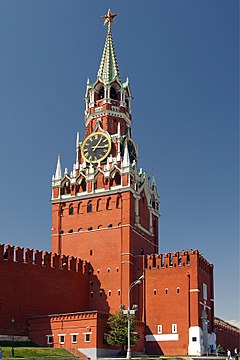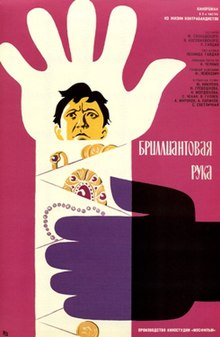Viking is a 2016 Russian historical action film about young knyaz Vladimir the Great who consolidated Rus' realm from modern-day Belarus, Russia and Ukraine to the Baltic Sea and solidified the frontiers against incursions. Originally a follower of Slavic paganism, Vladimir converted to Christianity in 988 and Christianized Rus'.
понедельник, 16 января 2017 г.
пятница, 13 января 2017 г.
четверг, 10 марта 2016 г.
Spasskaya Tower
Spasskaya Tower
From Wikipedia, the free encyclopedia
| The Spasskaya Tower | |
|---|---|

The Spasskaya Tower
| |
| General information | |
| Location | Moscow, Russia |
| Height | 71 m |
The Spasskaya Tower (Russian: Спасская башня, translated as "Saviour Tower") is the main tower with a through-passage on the eastern wall of the Moscow Kremlin, which overlooks the Red Square.
History[edit]
The Spasskaya Tower was built in 1491 by the Italian architect Pietro Antonio Solari. Initially, it was named the Frolovskaya Tower after the Church of Frol and Lavr in the Kremlin (no longer there). The tower's modern name comes from the icon of Spas Nerukotvorny (The Saviour Not Made by Hands), which was placed above the gates on the inside wall in 1658 (it was removed in 1917) and the wall-painted icon of Spas Smolensky(Smolensky Saviour), which was created in the 16th century on the outside wall of tower (plastered over in 1937, reopened and restored in 2010). The Spasskaya Tower was the first one to be crowned with the hipped roof in 1624–1625 by architects Bazhen Ogurtsov and Christopher Galloway (a Scottish architect and clockmaker). According to a number of historical accounts, the clock on the Spasskaya Tower appeared between 1491 and 1585. It is usually referred to as the Kremlin chimes (Кремлёвские куранты) and designates official Moscow Time.
The tower gate was once the main entrance into the Kremlin. In czarist times, anyone passing through the gates had to remove their headgear and dismount their horses. This tradition was broken in the soviet era. Cars approached the gate head on from the place of skulls and the road beside GUM. In order to pass through the gate, you had to be a head of state, top politburo member, or top government member. All other traffic was routed through the borovistky gate. The spassky gate posed an issue following the collapse of communism. In the new capitalist and market based economy, the passage of vehicles disrupted the flow of pedestrians to GUM and other shopping centers, even though few vehicles actually passed through the gate each day. In 1999, the decision was made to finally close the gate to all traffic. The signal lights and guard platforms still remain. The gate is used occasionally when repairs must be made to the borovissky gate. However, in that case, all traffic is routed from vasilievsky spusk. Nowadays, the gate opens to receive the presidential motorcades on inauguration day, for the victory parades, and to receive the new years tree.
суббота, 20 февраля 2016 г.
суббота, 13 февраля 2016 г.
The Diamond Arm Movie
Watch full movie online (Russian subtitles available).
The Diamond Arm
| The Diamond Arm | |
|---|---|

Film poster
| |
| Directed by | Leonid Gaidai |
| Written by | Leonid Gaidai Yakov Kostyukovsky Moris Slobodskoy |
| Starring | Yuri Nikulin Nina Grebeshkova Andrei Mironov Anatoli Papanov Nonna Mordyukova |
| Music by | Aleksandr Zatsepin |
| Cinematography | Igor Chernykh |
| Edited by | Valentina Yankovskaya |
| Distributed by | Mosfilm |
Release dates
| April 28, 1969 |
Running time
| 100 minutes |
| Country | Soviet Union |
| Language | Russian |
The Diamond Arm (Russian: Бриллиантовая рука Brilliantovaya ruka) is a 1969 Soviet comedy film filmed by Mosfilm and first released in 1969. The film was directed by director Leonid Gaidai and starred several famous Soviet actors, including Yuri Nikulin, Andrei Mironov, Anatoli Papanov, Nonna Mordyukova and Svetlana Svetlichnaya. The Diamond Arm has become a Russian cult film and is considered by many Russian contemporaries to be one of the finest comedies of its time. It was also one of the all-time leaders at the Soviet box office with over 76,700,000 theatre admissions in the Soviet era. The plot of the film was based on a real-life news item about Swiss smugglers who tried to transport jewels in an orthopedic cast.
Plot
The boss of a black market ring (known only as "The Chief") wants to smuggle a batch of jewelry from a foreign state into the Soviet Union by hiding it inside the orthopedic cast of a courier. The Chief sends a minor henchman named Gennadiy Kozodoyev (played by Mironov) to serve as the courier. Kozodoyev travels to Istanbul via a tourist cruise ship. The Turkish co-conspirators do not know what the courier looks like; they only know that he is supposed to say a code word to identify himself. Due to a mix-up, they mistake Kozodoyev's fellow passenger from the cruise ship, the "ordinary Soviet citizen" Semyon Gorbunkov (played by Nikulin) for the courier. They place a cast around his arm and put the contraband jewels inside the cast. Upon the cruise ship's return to the Soviet Union, Gorbunkov lets the police know what happened, and the police captain, who is working undercover as a taxi driver, uses Gorbunkov as bait to catch the criminals. Most of the plot are various attempts of The Chief's inept henchmen, Kozodoyev and Lyolik (played by Papanov), to lure Gorbunkov into a situation where they can quietly, without a wet job, remove the cast and reclaim the contraband jewels. In the meantime, Gorbunkov's wife begins to suspect that he has either been recruited by foreign intelligence, or is having an affair...
суббота, 23 января 2016 г.
четверг, 21 января 2016 г.
Video: Swans / Altai Krai
На территории Алтайского края, в 60 км от г. Бийска, расположены небольшие незамерзающие всю зиму озера, со дна которых бьют ключи, сохраняющие температуру +4…+6°С. Это единственное место в России, где остаются на зимовку лебеди. С 1973 года эта территория охраняется государством. В последние годы в водоемах заказника "Лебединый" зимует больше четырех сотен лебедей и около 2 тысяч диких уток.
Our website may contain affiliate marketing links, which means we may get paid commission on sales of those products or services we write about. Unless stated otherwise, our editorial content is not influenced by advertisers or affiliate partnerships. This disclosure is provided in accordance with the Federal Trade Commission's 16 CFR § 255.5: Guides Concerning the Use of Endorsements and Testimonials in Advertising.

























